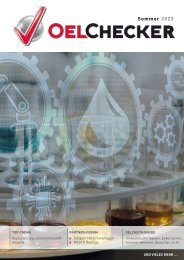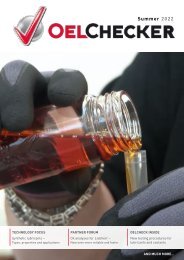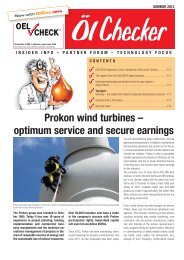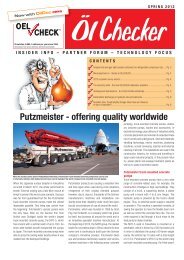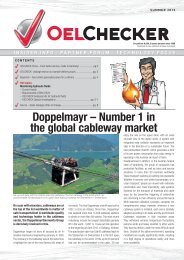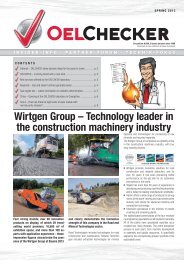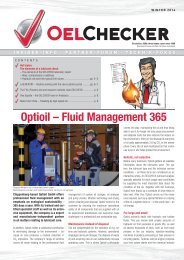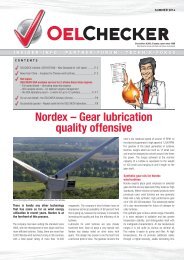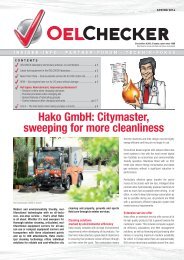OELCHECKER - Winter 2012
> OELCHECK China – Getting ready before the new laboratory opens > OELCHECK Laboratory – quicker and more accurate with a new particle counter > Hot Topics: The analysis of lubricating greases > Correct sampling > Most important analysis methods > Experience of our experienced tribologists > In demand – optimising online documentation of laboratory reports > and much more...
> OELCHECK China – Getting ready before the new laboratory opens
> OELCHECK Laboratory – quicker and more accurate with a new particle counter
> Hot Topics: The analysis of lubricating greases
> Correct sampling
> Most important analysis methods
> Experience of our experienced tribologists
> In demand – optimising online documentation of laboratory reports
> and much more...
You also want an ePaper? Increase the reach of your titles
YUMPU automatically turns print PDFs into web optimized ePapers that Google loves.
Dropping point analysis<br />
RULER with grease specimen<br />
Soxleth extraction<br />
Analysis of acid values<br />
• Greases with different thickeners which have<br />
been mixed together. In general this reduces the<br />
dropping point. The used grease does not just<br />
become softer. It often reacts like a semi-fluid<br />
product when the temperature rises.<br />
• The grease contains water or other foreign fluids.<br />
• Under extreme load the grease shears into extremely<br />
small particles. The soap structure has<br />
collapsed and can no longer bind the base oil.<br />
Re-lubrication intervals with the RULER<br />
The RULER test, a process based on cyclical voltametry,<br />
establishes the amount of amino and phenol<br />
oxidation inhibitors in a grease sample.<br />
Like all oil, even lubricating greases are altered<br />
by factors such as time and temperature. That is<br />
why, in addition to EP and AW additives, they also<br />
contain antioxidants. These can break down. The<br />
re-lubrication intervals and amounts must be<br />
adapted to decreasing additive levels.<br />
IR spectroscopy can be used to accurately determine<br />
the development of oxidation in mineral-oilbased<br />
greases. No IR oxidation figures can be calculated<br />
for synthetic base oils. That is why oxidation<br />
cannot be determined for high temperatures grease<br />
using the FR-IT spectroscopy. The RULER test is<br />
used for such greases in particular.<br />
Information about RULER tests<br />
By comparing the curves of fresh and used greases:<br />
• the remaining lifespan of a grease can be<br />
determined.<br />
• the best time for the next re-lubrication due to oil<br />
ageing can be calculated.<br />
Base oil viscosity using<br />
Soxhlet extraction<br />
As base oil viscosity is one of the decisive factors<br />
when trying to calculate bearing life spans, most<br />
lubricant grease manufacturers provide information<br />
on the viscosity of the base oil that is being used.<br />
However, there are no clear regulations regarding<br />
this matter. In general, high viscosity is considered<br />
better. To be able to indicate high viscosity, all fluid<br />
components such as oil, additives, adhesive additives,<br />
VI improvers are mixed. The viscosity is stated<br />
based on this mixture. However, this viscosity has<br />
very little in common with the way that viscosity is<br />
calculated for oil used in roller bearings because<br />
the grease no longer releases some parts of the<br />
thickener on to the bearing track.<br />
The Soxhlet apparatus can separate the liquid<br />
grease component from the thickener. The oil<br />
which is extracted in this process only contains liquid<br />
components. Polymer or adhesive supplements,<br />
VI improvers and even solid lubricants remain in the<br />
thickener.<br />
Information about base oil viscosity<br />
After the oil-based components have been divided<br />
from the soap, information can be provided about<br />
the oil and thickener levels in a grease. Separating<br />
them into solids and oil makes it possible to carry<br />
out a detailed analysis of the base oil that has been<br />
used, with respect to:<br />
• its viscosity – whether it is highly viscous or not<br />
and what viscosity level is actually available to<br />
the bearing surface.<br />
• its base oil composition – mineral or synthetic.<br />
• its proportion of additives, such as EP additives,<br />
antioxidants and corrosion inhibitors.<br />
Neutralisation number<br />
Even greases can turn „sour“. Oxidation of base<br />
oil, the breakdown of wear protection additives<br />
or the entry of salted fluids result in the development<br />
of acids in the lubricant grease. These can<br />
destroy alkaline thickeners so that the grease takes<br />
on a soup-like consistency and the base oil and<br />
soap residue separate. The grease runs off the<br />
bearing surface. Unless it is re-lubricated at regular<br />
intervals, bearing failure may occur.<br />
The experience our OELCHECK diagnostic engineers have<br />
Over 100 grease samples arrive at the OELCHECK laboratory in Brannenburg every day. The analysis values provide significant information about the used<br />
grease and the element it has lubricated. The OELCHECK diagnostic engineers examine the interaction of analysis values, detect mixings, impurities, wear<br />
and suggest causes of bearing failure. They recommend optimised amounts and different intervals for re-lubrication. During their work they benefit from their<br />
knowledge of lubricating greases and their practical use, as well as from the largest database of grease analyses from around the world. They investigate wear<br />
processes on a daily basis. Their experiences below regarding indications of different kinds of wear are confirmed again and again.<br />
Normal wear process<br />
The elements which are typically involved in wear<br />
register only a slight increase.<br />
•The values for iron (Fe) reach around 80 mg/kg,<br />
for chromium (Cr) 10 mg/kg and for copper (Cu)<br />
50 mg/kg.<br />
•The PQ Index is lower than 60.<br />
•Water content is less than 500 ppm<br />
•The RULER value is clearly over 25%.<br />
•The bleeding test is between 5% and 25%.<br />
Corrosive wear is present<br />
Waters, acids and/or oxidation caused the formation<br />
of rust and corrosion. The elements typical of<br />
wear have risen relatively strongly.<br />
• The values for iron (Fe) are over 150 mg/kg,<br />
for chromium (Cr) over 15 mg/kg, and/or for<br />
copper (Cu) over 50 mg/kg.<br />
• The PQ Index is clearly lower (more than 15%)<br />
than the iron value. Since rust particles are only<br />
marginally magnetisable, a grease polluted with<br />
rust particles will register a low PQ Index.<br />
• With used grease, the value for sulphate ash<br />
has increased by more than 2%.<br />
• The RULER value fell below 25%.<br />
• More than 2,000 ppm of water are present;<br />
there are increased levels of calcium (Ca),<br />
sodium (Na) and potassium (K).<br />
Wear through material fatigue<br />
Bearings and/or grease have reached the end<br />
of their lifespan. This has resulted in pittings,<br />
chipping, or other damage.<br />
• The wear metals have only increased slightly.<br />
• The PQ Index is more than twice as high as the<br />
iron value in mg/kg because the iron particles<br />
are so large that they cannot be stimulated by<br />
the AES procedure.<br />
• The PQ Index registers values far above 300.<br />
• The value for sulphate ash in used grease has<br />
increased by more than 2%.<br />
• The bleeding patterns and the proportion of<br />
base oil remaining in the used grease have<br />
changed considerably.<br />
Mechanical-abrasive wear<br />
• Wear metals have increased relatively strongly.<br />
• The value for iron (Fe) is over 100 mg/kg and for<br />
chromium (Cr) over 10 mg/kg.<br />
• Silicon (Si) and often potassium (K), calcium (Ca)<br />
and/or aluminium (Al) reach values of over<br />
50 mg/kg.<br />
• The PQ Index is higher than 150.<br />
• With used grease, the value for sulphate ash<br />
has risen by more than 2%.<br />
Recommended activity<br />
• If you plan to switch to another variety of grease,<br />
or if the individual values have changed so considerably<br />
that the laboratory report is labelled<br />
with a „?“ or „!“ symbol, the used grease still<br />
present should be removed from the lubrication<br />
point. Where possible, this should also<br />
be cleaned. If this is not possible, then larger<br />
amounts of grease must be used to re-lubricate<br />
more frequently.<br />
7




